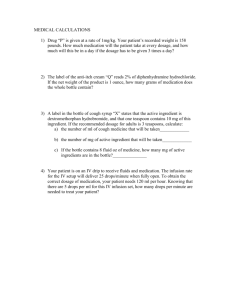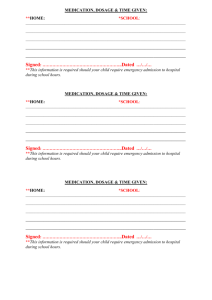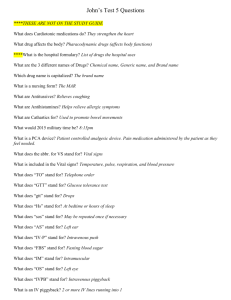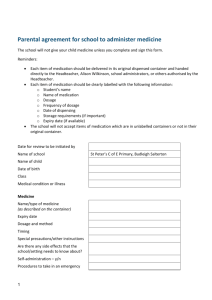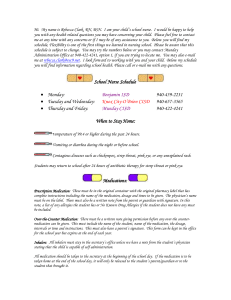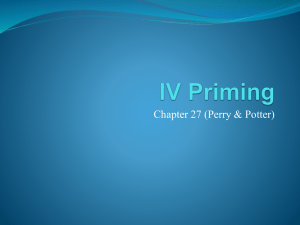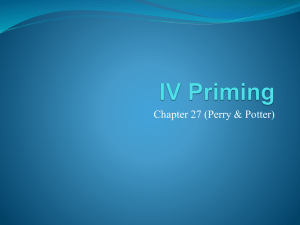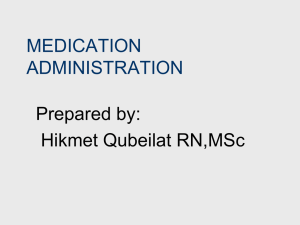oakland university school of nursing
advertisement
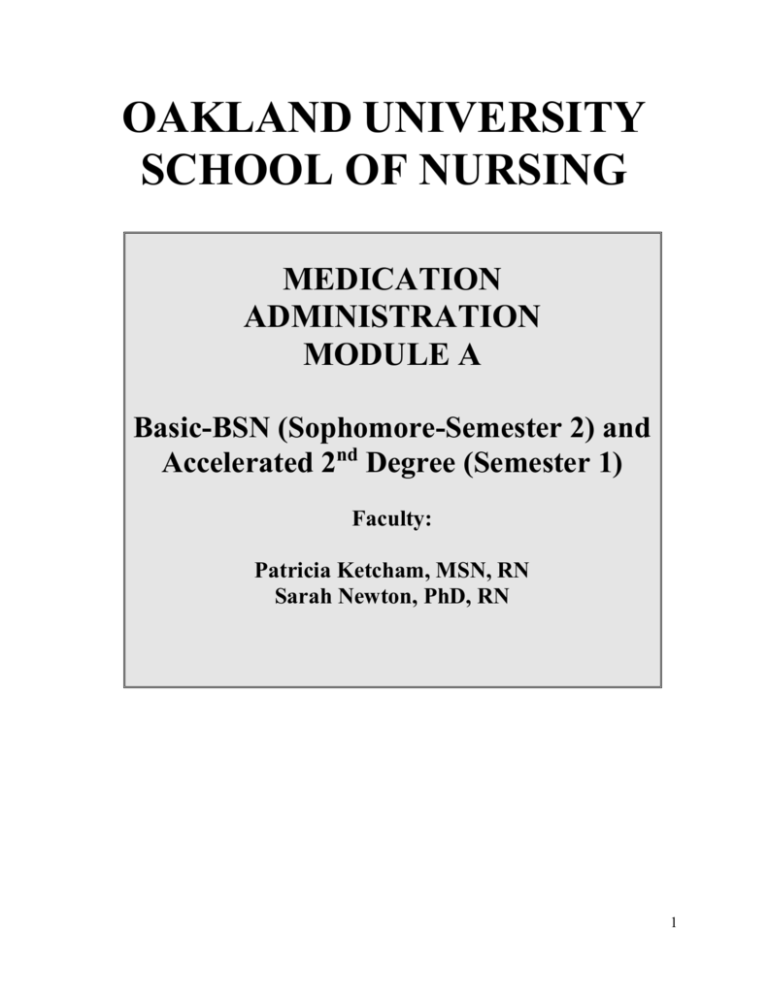
OAKLAND UNIVERSITY SCHOOL OF NURSING MEDICATION ADMINISTRATION MODULE A Basic-BSN (Sophomore-Semester 2) and Accelerated 2nd Degree (Semester 1) Faculty: Patricia Ketcham, MSN, RN Sarah Newton, PhD, RN 1 MEDICATION ADMINISTRATION EXAMINATION - MODULE A Introduction The purpose of the Medication Administration Examination (MAE) - Module A is to provide students with direction and review for the MAE (Basic-BSN Sophomore-Semester 2 and ASDSemester 1), and it serves as a foundation for Modules B and C. In most healthcare settings, the registered nurse (RN) is responsible for medication administration. A critical component of safe medication administration is accurate dosage calculation. RNs must be able to calculate patient medication dosages accurately and quickly, verify that medications provided by the pharmacy have been correctly calculated, and safely administer the medications that have been prescribed. Nursing students are expected to be able to apply previously learned mathematical concepts to the process of dosage calculation and employ effective critical thinking to ensure safe medication delivery. Module Objectives At the completion of this module, the student will be able to: 1. Convert dosages within and between measurement systems using metric, household, and apothecary systems. 2. Correctly interpret medical abbreviations and medication orders. 3. Demonstrate correct calculation of oral and parenteral medication dosages. 4. Correctly calculate intravenous flow rates, intravenous piggyback infusion rates, and duration of infusion. Required Textbook Pikar, G. D., & Abernethy, A. P. (2013). Dosage calculations (9th ed.). Clifton Park, NY: Delmar, Cengage Learning. (ISBN:13: 978-1-4390-5847-3) Medication Administration Examination The MAE is administered to all Basic-BSN and Accelerated Second Degree nursing students at each level of the nursing curriculum. The date, time, and location for the exam is announced on the School of Nursing (SON) website. Please refer to the SON Undergraduate Student Handbook for information related to the MAE policy and requirements. On the MAE, you need to show all calculations, label the answer correctly (mL, mg, gtt/hr, mg/dose, etc.), and circle your answer. 2 Required Readings Section 1: Basic Math Review Complete the Mathematics Diagnostic Evaluation (pp. 28-30) and check your answers to determine your need for further independent practice of basic mathematical skills. If you identify specific problems, review basic math skills in Chapters 1 and 2. The OU Study Skills Center located in North Foundation Hall provides tutoring services for basic math skills by appointment. Section 2: Systems of Measurement Chapters 3, 4, 5, 6, 7, 8, and 9 Read and review these chapters. Complete review sets found in each chapter and the selfevaluation for this section on pages 199-204. Students are not required to memorize all conversions found in the textbook. ONLY THE CONVERSION CHARTS, TABLES A AND B, IN THIS MODULE NEED TO BE MEMORIZED . Section 3: Drug Dosage Calculation Chapter 10, 11, 12, and 14 Read and review these chapters. Complete review sets in each chapter and the selfevaluation for this section on pages 423-436. Section 4: Intravenous Solutions, Equipment and Calculations Chapter 15 Read and review this chapter. Complete review sets in the chapter and the self-evaluation for this section on pages 439-488. For the Level I MAE, the focus is calculating intravenous (IV) solution flow rates for electronic or gravity infusion systems. Table A TABLE OF EQUIVALENTS/CONVERSIONS APOTHECARY 1 fluidounce (fl oz) 16 fluidounces 32 fluidounces 1 grain (gr) 15 grains 2.2 pounds (lb) METRIC 1 Milliliter (mL) 4 mL – 5* mL 15*mL/16 mL 30 mL 500 mL 1000 mL or 1 L 60* – 65 Milligrams (mg) 1 gram (g) 1000 gm or 1 Kilogram (Kg) 2.54 cm HOUSEHOLD 15 drops (gtt) 1 teaspoon (t, tsp) 1 tablespoon (T, tbsp) 2 tablespoons 1 pint (pt) 1 quart (gt) 2.2 lb 1 inch *These numbers are the normal ones used for conversions 3 Table B COMMON METRIC CONVERSIONS 1 Liter (L) 1 Kilogram (Kg) 1 Gram (g) 1 Milligram (mg) 1000 milliliters (mL) 1000 grams (g) 1000 milligrams (mg) 1000 micrograms (mcg) Table C STANDARD AND INTERNATIONAL/MILITARY TIME Standard AM 1:00 2:00 3:00 4:00 5:00 6:00 7:00 8:00 9:00 10:00 11:00 12:00 (noon) Intl/Miltary AM 01:00 02:00 03:00 04:00 05:00 06:00 07:00 08:00 09:00 10:00 11:00 12:00 Standard PM 1:00 1:00 3:00 4:00 5:00 6:00 7:00 8:00 9:00 10:00 11:00 12:00 Intl/Military PM 13:00 14:00 15:00 16:00 17:00 18:00 19:00 20:00 21:00 22:00 23:00 24:00 Table D COMMON ABBREVIATIONS aa a.c. ad lib bid c caps c/o DAT D5W elix ID I.M. I.V. IVPB KVO LA NKA NPO OTC pc NS of each before meals as desired twice a day with capsules complains of diet as tolerated dextrose 5% in water elixir intradermal intramuscularly intravenously intravenous piggyback keep vein open long acting no known allergies nothing by mouth over the counter after meals Normal Saline po prn qam qh q2h q3h q4h qid qs s SR SL Sol./soln. stat SubQ susp. syp. tab tid ung/oint. by mouth when required every morning every hour every two hours every three hours every four hours four times a day quantity sufficient without sustained release sublingual solution immediately subcutaneous suspension syrup tablet three times a day Ointment 4 Institute for Safe Medical Practice & Joint Commission on Accreditation of Healthcare Organizations Guidelines for Abbreviations Do Not Use Recommended Write “units” Write “international unit” Write ‘daily’ Write “every other day” Write “bedtime” or “half strength” Write “Sub Q” Write “discontinue” or “discharge” Write “mL” Write “left ear”, “right ear”, or “both ears” Write “at” Write “by mouth” Write drug name in full Write sliding scale Write “right eye, left eye, both eyes” U IU QD QOD HS SC or SQ DS or D/C cc AD, AS, AU @ Per OS Abbreviation for drug names SS OD, OS, OU METHODS OF CALCULATION A. Drug Dosage Calculations D = Desired Dose H = Dose on Hand Q = Quantity (form and amount drug comes in, tabs, caps, mL. Rounding: For purposes of this module, calculate all problems to 2 decimal points (e.g., 1.7596 mL would be rounded to 1.76 mL). In actual clinical practice, these numbers may be rounded to 1 decimal point (e.g. 1.7596 would round to 1.8) in order to draw up medications, pour medication into a cup, or providing a tablet to a patient. Formula-Basic Formula (most current method) Convert Units to One System X (amount) = D (desired) x Q (quantity) H (have) Evaluate answer. B. IV Infusion Rates 1. Infusion Pump : Calculate mL/hr of infusion Amount of fluid ÷ Hours to administer = mL/hr 5 2. Regulation of flow rate (gtt/min) by gravity flow a. 1 step formula for primary and secondary (IVPB infusion) Amount of solution x gtt/mL of the IV tubing set ----------------------------------------------------------- = gtt/min Minutes to Administer b. 2 Step method for primary infusions Step 1: Amount of fluid ÷ hours to administer = gtt/min Step 2: mL/hr x IV tubing (set) drop factor = gtt/min 60 min Evaluate answer. 3. If a medication is added to an IV bag, then add the medication volume to the amount in the bag for a total amount of fluid. This total will be used for calculation purposes. For example, if 20 mL of KCL is added to 1000 mL NS, then the total amount of solution is 1020 mL. (The textbook presents two thoughts on this rule, but it is always safe practice to add the medication volume and is especially important when caring for infants and children.) 4. Work the problem to 2 decimal places and then round to the whole number for setting the drip rate in clinical practice (e.g. 83.95 =84 gtt/min). C. Reconstitution/Solutions from Powders A powdered drug is reconstituted (dissolved) with fluid (e.g. sterile water) following the manufacturer’s directions to become a solution. The powder will increase the volume of the fluid. Thus, the reconstituted solution will always be more than the original volume of diluent. The drug dosage is based on the total volume. 6

